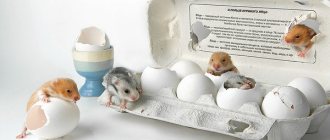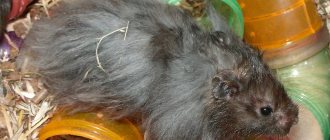The appearance of a new pet in the house is a troublesome and responsible matter. There is no need to rush into buying a fluffy animal; it is better to prepare well for this event and decide in advance how to set up a hamster cage with your own hands, what food is best for your future pet and what to use as bedding.
Types for home keeping
When buying a hamster, you should pay attention to the species to which it belongs, since each of them has its own characteristics of keeping.
There are about 240 species of hamsters in nature, but much fewer can live at home. We will introduce you only to the most popular of them.
Dzungarian . One of the most popular species among breeders, along with the Syrian. The body length of its representatives is up to 10 cm, body weight is 35-65 g. They can be easily recognized by the dark vertical stripe along the back and the diamond shape on the forehead.
They come in different colors: white, black, brown, gray. Their life expectancy is 2-2.5 years. Under good conditions, some individuals live up to 4 years.
Find out more about keeping and breeding Djungarian hamsters.
Campbell's . Similar to the previous species, it is included in the same genus of hairy-footed hamsters. It has a body 7-10 cm in length and 25 g in weight. The traditional coloration of wild hamsters is dark gray with brown and a dark vertical stripe along the body. The fur of representatives who live at home can be colored in various shades - from white to black. The most common brown shades. Their maximum lifespan under good conditions is 4 years.
Roborovsky . This dwarf hamster barely grows to 5 cm. It weighs about 30 g. The fur on its head and back is sand-colored, and its abdomen is white. There are light spots above the eyes. In captivity, this animal can live 2-3 years.
Important! If your choice fell on the Roborovsky hamster, then you need to take into account the fact that it is not suitable for solitary living. It is better to choose aquariums or terrariums with high walls as its home.
Syriac (Nast Asian) . The body length of adult individuals of this species can be up to 14 cm, weight - 100-130 g. It is covered with soft short fur of golden color. The life expectancy of representatives of this species with proper care is 2.5-3 years.
One of the varieties of Syrian hamsters are long-haired - Angora. They are characterized by long, fluffy fur up to 5 cm in length. The coat has different colors - from light beige to black. Tortoiseshell and spotted Angora hamsters are also found.
Taylor . Another dwarf species. It has a body up to 8 cm long and weighing up to 20 g, covered with thick fur. Its chest and belly are white, its back and back of its head are brown. The average lifespan of Taylor's hamsters is 2-2.5 years.
Litter
The best bedding for a hamster's home is sawdust, which must be soft. It is recommended to use aspen or pine sawdust, but without a pronounced odor. Soft paper, such as napkins, is also suitable for bedding. Hard paper, and especially newspapers, should not be used.
Sawdust absorbs odors well, so you will have to clean your home less often than a cage or aquarium with paper bedding. But many hamsters are allergic to sawdust. Inhaling dust, they begin to sneeze. There are no such problems with paper. Nevertheless, sawdust is still more similar to natural soil.
Under no circumstances should cotton wool be used as bedding. The hamster may get its paw caught in it. Trying to free it, the animal will tighten the fibers even more, which will cut into the skin and tighten the blood vessels.
A false bottom is often used in terrariums and aquariums. It is a plastic sheet with many holes, which is installed 2 cm above the bottom of the cage. This bottom allows or actively absorbs moisture, which allows you to save on the purchase of hygiene products.
At what age is it better to buy
Hamsters do not live long, but there is no need to rush to pick them up from the breeder. Babies up to 21 days old should be with their mother. They can be weaned from 22 to 28 days, but no later. The optimal age for purchasing a pet is 1.5-2 months, but not older. Older individuals will be more difficult to accustom to a tray and a new place of residence.
When purchasing, the breeder must provide the buyer with food for the first time and the bedding on which the hamster lived. The familiar smell and menu will allow him to quickly adapt to new conditions.
Find out how much a hamster costs and how to keep it, how to train a hamster to respond to its name.
If you have already decided on the type and color of the animal, we recommend that you familiarize yourself with the recommendations for choosing the right one. When purchasing from a pet store or from a breeder, first of all, you should pay attention to the following points :
- appearance of the animal - it should look healthy, be active, well-groomed;
- condition of the coat - dull fur with scabs and bald spots indicates health problems in the rodent;
- eyes - they should be alive, shiny, not cloudy;
- nose - should be dry and clean;
- anus - it should be dry, clean, odorless and discharge-free;
- behavior - it is better to refuse to purchase an aggressive individual in order to avoid further problems with its maintenance; you should also not buy a lethargic and sleepy rodent.
If you are buying a hamster that can live alone and do not plan to give it neighbors, then it is advisable that it be a male.
The sex of these rodents can be determined when they reach the age of 1 month. Important! Before purchasing a hamster of any kind, you should familiarize yourself with information about what conditions they require. You should only get an animal if you are able to provide these conditions
.
Requirements for “dwelling”
Caring for and maintaining a Djungarian hamster requires a minimum amount of knowledge. Only conditions close to the natural habitat will make the baby’s life comfortable and long.
It is better to get a glass or plastic terrarium as a place of residence - this way the animal will definitely not run away anywhere. There should be at least 0.15 square meters per rodent. m of usable area, that is, the length of the walls should be 30 and 50 cm.
The aquarium (terrarium) should not have too high walls. Firstly, it is impossible to provide normal ventilation in such a home. Secondly, the glass will sweat, and therefore will become an excellent place for germs to multiply, which can affect the baby’s health.
By the way, it is better to keep pets alone. In a couple or a large company, clashes often arise; animals injure each other and may even die in another battle for territory. Even if the Dzungarians behave peacefully, this does not mean friendly relations - most likely, they live in constant stress, expecting an attack at any moment.
Organization of space:
- bedding - sand, sawdust, they should absorb moisture well and absorb odor, you should not use cotton wool, newspaper, toilet paper and various rags;
- tray with litter for the toilet;
- a house with holes, you don’t have to buy it, you can create improvised holes using roots, twigs and all kinds of plastic tubes;
- wheel - selected individually;
- drinking bowl and feeder.
Choosing and arranging a home
In order for your hamster to delight you with its presence for as long as possible, you need to create comfortable living conditions for it. Before you go to the pet store to select a rodent, you should purchase a cage for it. You can make these two purchases at the same time, but having previously decided on the place where the home will be located.
Size and material
The size of the cage will depend on the type of hamster you are getting, the length of its body, and also on the number of individuals that will live in it. So, for one representative of dwarf species, a dwelling 50 cm long, 30 cm high and wide will be sufficient. If several individuals are planned, then these parameters are accordingly multiplied by their number.
For medium-sized hamsters, the cage should be at least 60 cm long and 40 cm high and wide.
We advise you to read about choosing and arranging a cage for a hamster.
As for housing materials, most often hamsters are kept in cages with metal bars. Species such as Djungarian and Roborovsky can live in plastic cages, but you will need housing made of special plastic that is suitable for keeping rodents and is safe for them. Dwarf species can be kept in aquariums and terrariums as they have a habit of escaping through gaps between metal bars. Narrow glass vessels with high walls are not suitable for these purposes.
Video: choosing a cage for a hamster
How many hamsters should you keep in one cage?
This will depend on the type you purchase. So, for example, we have already mentioned that Roborovsky’s hamster cannot stand being alone. At the same time, it is not recommended to keep Syrian hamsters, especially same-sex ones, in the same cage. Fights, bites and torn pieces of fur cannot be avoided in such a situation. Djungar females and males also engage in fights for territory. Therefore, they very rarely coexist in the same cage. They are brought together only for the time of mating.
Before thinking about the number of individuals in one cage, we advise you to inquire about the behavioral characteristics of representatives of the species that you plan to purchase. Also check this point with the breeder or pet store.
Did you know? Hamsters, like most rodents, do not stop growing teeth until the end of their lives. Therefore, they have to constantly grind them down.
What does a hamster need in a cage?
For a rodent to live comfortably in a cage, it will need to be equipped with items necessary for nutrition, hygiene, and play. Here is a minimum list of what should be in a hamster’s home:
- feeder;
- drinking bowl;
- tray;
- mineral stone;
- wheel;
- litter
Feeder . It is advisable that the hamster have a bowl for food. However, you can also feed it by scattering food on the litter. Which method to choose is up to you. Note that the last option is the best if the cage contains several individuals. However, it will require additional cleaning. When feeding from a bowl, the owner can control the amount of food eaten to avoid overeating. Hamster feeders are usually made of ceramic or plastic.
Drinking bowl . It is attached to the outside of the cage, with a spout placed inside from which the animal will drink. Water must be changed daily.
Tray . A small hamster can be trained to defecate in a litter tray. So you only have to change it every day. If there is no tray, the animal will defecate on the bedding. This option is also allowed, but will require more cleaning effort. It is best to use corn substrate as a filler in the tray.
Mineral stone . The rodent needs it to grind its teeth. The animal also needs to periodically put wooden sticks in the cage.
Wheel . This item is a must for hamsters because physical activity is important for a healthy animal. In addition, like any other rodent, the hamster loves to play. The wheel must be selected according to the size of the animal. For representatives of the Djungarian and dwarf species, a device with a diameter of 20 cm is suitable. For larger rodents, including Syrian ones - 30 cm.
It is necessary to avoid buying wheels with crossbars and made of mesh - there are often cases when an animal’s paws get stuck in them and are injured.
Litter . Another mandatory attribute in the cage is a substrate, which needs to fill the bottom of the cage with a layer of 6 cm. It is necessary to ensure that the animal is warm to move around the floor, so that it can dig there and to absorb its urine. Wood shavings (except coniferous) are most often used as bedding today. It can also be hay, wood, cellulose, corn, clay, cat litter.
The rodent must be provided with material for building a nest - paper napkins, scraps of toilet paper, or special paper purchased at a pet store. It is prohibited to use cotton wool and wool for these purposes.
If the size of the cage allows, then the pet will need to install a house where it will hide from prying eyes, save supplies and relax.
It is also advisable to equip the cage with toys - for grinding teeth, climbing (tunnels, ladders, crossbars, labyrinths).
Important! To avoid spilling the filler on the floor, you can place the cage in a cardboard box of a suitable size, cutting off its sides to 10 cm in height from the floor.
Video: setting up a hamster cage
Where to put it in the room
The choice of location for the cage should be taken very seriously. The pet’s health, well-being, and therefore activity will depend on this. Here are a few rules to follow when keeping hamsters :
- The hamster house should be located away from heating, electric and gas appliances.
- It is forbidden to place the cage in drafts, near the front door.
- You should avoid installing housing for hamsters in rooms where the lights are turned on at night, the TV or computer are on.
- The temperature in the room where the rodent lives should be within +20-24 °C.
If you do not adhere to the above recommendations, the hamster will live in stressful conditions, which means its life expectancy will be significantly reduced.
Themed cage decoration
It is human nature to decorate his home, to subordinate everything that is in his field of vision to the overall design, so sooner or later the question arises about decorating the home of a furry pet.
You can decorate the hamster cage in accordance with the general style of the room where it will be located.
If this is a children's room, it would be appropriate to stylize the hamster's house as a castle or fortress, and various thematic bridges and ladders will complement the picture.
Lock cage for hamster
A cage with a house made of real coconut husk or an inverted flower pot with a sawn-out entrance hole and a reed bridge would look interesting in the kitchen.
By placing the cage in the living room in a high-tech style, you can create a whole spaceport for your pet. A house that smoothly turns into a vertical rocket tunnel and climbing frames in the form of radars, a toilet corner and a feeding trough, veiled as storage rooms, will look very futuristic in certain lighting.
Hamster cage in high-tech style
A cage designed “to resemble an old water mill” looks original, where the running wheel becomes the central object, and the hamster’s house turns into a mill with blades.
New Year's decoration
Under no circumstances should you put real spruce branches in the cage; the hamster will definitely try to gnaw it, and the resinous substances are harmful to his body. Tinsel should also be prohibited. If you wish, you can decorate the cage with things that are edible and harmless to the fluffy: a carrot decorated with raisins and dried apples, or a “snowman” made from cottage cheese are suitable as a Christmas tree.
Garlands can be cut from cucumber or any other hamster-safe vegetable or fruit with a special knife.
What do hamsters eat at home?
Hamsters are fed once or twice a day: morning and evening. They are unpretentious in nutrition and require very little feed.
What can you feed
Pet food will need to be purchased at a pet store. His main diet should consist of a grain and granular mixture. However, you cannot completely feed an animal with store-bought food alone. At least twice a week, the animal’s menu should be replenished with fruits, vegetables, and herbs. Twice a week you can give protein food in the form of chicken protein, boiled chicken meat, cottage cheese. Occasionally, the animals are pampered with berries: strawberries, raspberries, grapes.
How to care for a hamster
High-quality care for an animal is the key to its longest life and health. Caring for a hamster means cleaning the cage, trimming claws and caring for teeth and fur.
Regular walks
It is not recommended to walk with a hamster on the street, since this way it can catch some disease.
You should also not let it out on the floor in the apartment. Due to its small size, it runs the risk of crawling into very secluded places where it will be difficult to find.
For regular walks, special balls with a diameter of 16-18 cm (depending on the size of the animal) are perfect. A rodent can run in them for no longer than 25 minutes.
The walking ball allows the hamster to move freely and safely around the room, helping him maintain the necessary activity.
A specially equipped pen measuring 1x1 m would also be an excellent solution for a walk.
Video: walking ball for a hamster
Care for claws and teeth
Hamsters are able to take care of themselves, including their claws and teeth - you just need to provide them with objects on which they can grind them down. If you still see the need to trim your pet’s claws, then you will need a special nail clipper for this.
Cleaning the cage
Every day you will need to wash the food bowl, change the water in the drinking bowl, remove the tray, or replace the bedding locally in the place where the hamster went to the toilet.
General cleaning of the cage with a complete replacement of the bedding should be done once a week . Allowed - three times a month.
It is important that when cleaning, the hamster is not present in the cage and does not see the work of your hands.
Is it possible to bathe
Hamsters prefer to clean their fur in sand . Therefore, once a week you will need to place a container with sand in the cage, in which it will be convenient for the rodent to “splash around”.
If such a sandbox is stationary, then the sand in it should be replaced once every 3 days.
Video: bathing a hamster in the sand
Water procedures are not included in the mandatory care of a hamster. Rodents do not like water, which means any bathing will be stressful for them. Therefore, it is necessary to lower the animal into water only in case of emergency. This must be done quickly, and during the procedure it is important to ensure that water does not get into the eyes, ears and nose. After bathing, the animal is dried with a soft towel. It is strictly forbidden to dry his fur with a hairdryer, as he is very afraid of loud noises.
Learn the advantages and disadvantages of keeping rodents in your home, such as rat, squirrel, degu, chipmunk, guinea pig, gerbil, jerboa, prairie dog, and dormouse.
Breeding
Golden hamsters are highly fertile. These rodents are capable of producing 3-5 litters per year. The female Syrian hamster is ready to reproduce from the age of 4 months. The male becomes sexually mature at 3 months.
For successful fertilization, a boy and a girl are placed in a spacious cage and live there for some time. After mating, the animals are resettled, since pregnant females become very aggressive.
After 18 days from the moment of fertilization, from 4 to 15 cubs are born. Until 30 days of age, babies feed exclusively on mother's milk, and at approximately 37 days they can already be moved to another cage.
Syrian hamsters are charming rodents with a pleasant appearance and a sociable, playful disposition. They are not picky in their diet and do not require complex care. If treated correctly, cute animals will become an inexhaustible source of positivity.
Pros and cons of content
We have already repeatedly noted that having a pet in the house is always a responsibility, and before purchasing one, you should weigh all the pros and cons. We tried to describe the main advantages and disadvantages of keeping a hamster in an apartment. We hope they will help you decide whether to have one in your home or not.
Advantages:
- goodwill - rodents, when treated and maintained correctly, rarely cause problems to the health and property of the owner;
- unpretentiousness - small portions of food and no need for street walks are, of course, a significant advantage of hamsters over other pets;
- ease of training and taming;
- the cage takes up little space;
- undemanding food;
- inexpensive price.
Flaws:
- disorder in the cage;
- unpleasant odor without regular cleaning;
- nocturnal lifestyle and, accordingly, the noise that is made;
- short life expectancy;
- rare manifestations of aggression.
Hand training
After acquisition, the animal must adapt to new conditions. During the first week, it is not recommended to touch the rodent or try to pick it up. Violent actions destroy the trusting relationship between pet and owner. You can get to know each other later, when the animal is ready to come out of hiding without fear when a person appears.
To pick up an animal, place a treat on your open palm and offer it to the hamster. If he ran into the house, there is no need to continue contact with him. You need to be patient.
When the rodent gets used to it a little and begins to climb onto your hand without fear in the cage, you can try to carry it in your hands through the door. In this case, you should hold your palm with a boat and monitor the pet’s behavior. He may suddenly run. If a rodent falls from a height, it will get hurt.
Hamsters love corn










